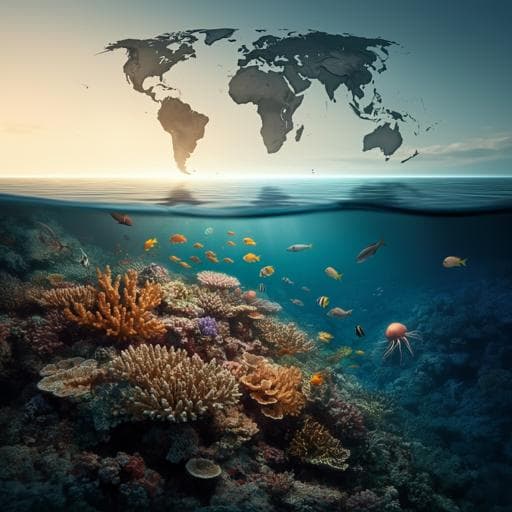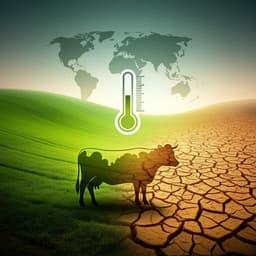
Earth Sciences
Impact of global climate cooling on Ordovician marine biodiversity
D. E. Ontiveros, G. Beaugrand, et al.
This groundbreaking study, conducted by Daniel Eliahou Ontiveros and colleagues, reexamines the Great Ordovician Biodiversification Event (GOBE) and reveals that global cooling may have been a key driver behind this significant increase in marine biodiversity. Discover how climate changes transitioned a warmer, inverted latitudinal biodiversity gradient into a modern one during the Ordovician period.
~3 min • Beginner • English
Introduction
The study addresses why marine biodiversity rose dramatically during the Great Ordovician Biodiversification Event (GOBE) following the Cambrian Explosion. Competing hypotheses include: (1) a decrease in tropical ocean temperatures from potentially deleterious levels (>40 °C) in the Cambrian to ~30 °C in the Early–Middle Ordovician; (2) paleogeographic fragmentation and sea-level rise creating new niches; (3) long-term atmospheric oxygenation; (4) frequent asteroid impacts creating ecological opportunities; and (5) trophic restructuring driven by increased phytoplankton diversity. Recent work challenges extraterrestrial and oxygenation hypotheses, leaving open whether extrinsic factors (climate, paleogeography) or intrinsic biological drivers dominated. This paper aims to establish causality by coupling a global climate model with a macroecological biodiversity model to quantify the roles of long-term Ordovician cooling and paleogeographic evolution (490–430 Ma) on marine biodiversity patterns.
Literature Review
The paper synthesizes prior hypotheses for the GOBE: extreme early Paleozoic warmth followed by cooling supported by temperature proxies; paleogeographic fragmentation/sea-level rise as a source of niche creation; atmospheric oxygenation trends inferred from isotopic proxies; asteroid impact frequency; and phytoplankton diversification altering trophic structure. Updated geochronology weakens the impact hypothesis, and multiple proxies suggest oxygen levels were not the main driver, with ocean redox remaining stable during the main GOBE phase. Debates persist over interpretations of oxygen isotope data: one view supports very high early Paleozoic temperatures (>40–50 °C at low latitudes), while another attributes the isotope trend to seawater δ18O changes, implying more moderate temperatures. Prior compilations and database biases (e.g., PBDB vs GBDB coverage) affect inferred biodiversity curves. The study positions itself to move beyond temporal correlations by mechanistically testing climate and geography as drivers.
Methodology
The authors couple a paleoclimate GCM (FOAM v1.5) with a macroecological model (SNCI/METAL) to simulate Ordovician marine biodiversity. Climate modeling: FOAM couples NCAR CCM2 (with CCM3.2 physics) at R15 (4.5°×7.5°, 18 levels) to OM3 (1.4°×2.8°, 24 levels) with thermodynamic sea ice (CSM1.4; Semtner 3-layer). Equilibrium simulations were run every 10 Myr from 490 to 430 Ma (7 time slices), using paleogeography from Marcilly et al. (2021). Solar constant followed Gough (1981) (1313.24 to 1319.7 W m−2 across the interval), circular orbit, obliquity 22°. Atmospheric greenhouse forcing varied only CO2 (treated as pCO2-equivalent) to reproduce the long-term Ordovician cooling from Song et al. (2019): 192, 96, 48, 24, 8, 6.1, and 4 PAL at 490, 480, 470, 460, 450, 440, and 430 Ma respectively (1 PAL = 280 ppm). Simulations were initialized with 35‰ uniform salinity and a warm ocean, run 2000 years to near deep-ocean thermal equilibrium (median drift 0.0035 °C/yr over last 100 years at 3700 m); mean annual fields from the last 50 years were used. Model performance and sensitivity acknowledge FOAM climate sensitivity ~3.5 K per CO2 doubling; other gases (e.g., lower O2) not varied. Macroecological modeling: The SNCI/METAL framework generates pseudo-species with unique thermal niches defined by lower and upper bounds (tmin = −1.8 °C, tmax = 44 °C) and niche breadths from 1 °C (stenotherms) to 45.8 °C (eurytherms). A pool of 101,397 niches was created; for each time slice, 10,000 pseudo-species were randomly sampled without replacement, repeated 100 times to form an ensemble. Species can occupy any grid cell where the mean annual upper-ocean (0–100 m) temperature falls within their niche; biodiversity is the count of pseudo-species whose niches overlap local temperature. Analyses focus on continental shelves (shallower than −250 m) and exclude polar regions (>60° latitude) and deep ocean to align with fossil data coverage. Outputs include spatial maps and global metrics (median richness per time slice with ±1 SD envelope). Sensitivity and attribution: (1) Constant-climate simulations with tropical SST ~30 °C using evolving paleogeography to isolate geographic effects; (2) additional runs under warmer climate (tropical SST ~40 °C); (3) physiological sensitivity varying tmax from 50 to 78 °C at 460 Ma, comparing warm vs cool climates using a Taylor diagram (correlation, RMSD, standard deviation) to quantify the threshold tmax that would suppress cooling-driven biodiversity changes. Model-data comparisons: Global biodiversity trajectories compared against Sepkoski et al. (1981), Fan et al. (2013; GBDB), and Rasmussen et al. (2019; PBDB); regional comparisons with brachiopod data for Laurentia, Siberia, South China, and Baltica.
Key Findings
- Tropical sea-surface temperatures simulated by FOAM decline from ~45 °C at 490 Ma to ~30 °C at 430 Ma, reproducing a long-term Ordovician cooling trend.
- The coupled model yields an inverted latitudinal biodiversity gradient (LBG) during the late Cambrian–Early Ordovician (biodiversity maxima at higher latitudes; low-latitude shelves too hot), transitioning to a modern-like LBG with low-latitude maxima as climate cools in the Mid–Late Ordovician.
- Global marine biodiversity increases monotonically from 490 Ma to ~450 Ma (Katian) and then stabilizes to 430 Ma, in first-order agreement with multiple fossil biodiversity curves (Sepkoski; GBDB; PBDB), without explicitly invoking intrinsic biological innovations.
- Attribution: Simulations with constant tropical SST (~30 °C) and evolving paleogeography show little change in biodiversity, indicating that continental drift alone does not drive the increase; climate cooling is the primary driver. The same conclusion holds under a warmer baseline (tropical SST ~40 °C) sensitivity.
- Mechanism: Ecophysiological thermal niche constraints generate a diversity–temperature peak at moderate temperatures (~15–25 °C), with maximum biodiversity around ~23 °C, consistent with theory and independent mechanistic models.
- Physiological sensitivity: Varying tmax shows that only unrealistically high thermal upper limits (>65 °C; more than 20 °C above the modern ~44 °C limit) would suppress the cooling effect on biodiversity. Correlation between warm vs cool state maps exceeds 0.95 only at tmax = 65 °C; RMSD is lowest for tmax between 68–78 °C, indicating robustness of the cooling-driven biodiversification under reasonable physiology.
- The model does not reproduce the Late Ordovician Mass Extinction (~445–443 Ma), likely due to omitted drivers (rapid Hirnantian cooling, sea-level fall, anoxia).
- Regional patterns: The model captures increases in Laurentia, Siberia, and South China (though timing differs, with earlier rises in Laurentia/Siberia). Baltica shows muted modeled change due to tracking a climatic belt during cooling; discrepancies likely reflect uncertainties in paleogeography (notably Baltica’s latitude), temperature reconstructions, model resolution, and database biases.
- The emergence of a modern-like LBG during the GOBE is attributed primarily to global climate cooling rather than paleogeography or historical contingency.
Discussion
The findings support climate cooling as the dominant extrinsic driver of the GOBE, directly addressing the study’s question by disentangling climate and paleogeography via controlled simulations. The mechanistic niche–temperature framework explains how cooling renders previously inhospitable low-latitude shelves habitable, establishing a modern-like LBG and increasing global biodiversity. Comparisons to fossil diversity curves demonstrate first-order agreement across multiple datasets, while sensitivity tests rule out paleogeography alone as sufficient and show that only implausibly high thermal limits could negate the cooling effect. This challenges interpretations emphasizing oxygenation or extraterrestrial impacts and aligns with evidence for stable ocean redox during the main GOBE phase. Regional mismatches (e.g., Baltica) highlight the importance of paleogeographic uncertainty and local environmental factors (e.g., carbonate shelf development) that the global model does not resolve. The results underscore climate’s central role in structuring biodiversity through deep time and suggest that moderate temperatures maximize ecological niche packing, with implications for understanding past and future diversity patterns.
Conclusion
By coupling a general circulation climate model with a macroecological niche-based model, the study quantitatively demonstrates that long-term Ordovician global cooling can, by itself, generate the principal features of the GOBE: a substantial rise in marine biodiversity and the first establishment of a modern-like latitudinal diversity gradient. Paleogeographic evolution alone does not reproduce these trends, and the cooling-driven mechanism is robust to reasonable uncertainties in temperature proxies and organismal thermal physiology. While intrinsic biological innovations and regional environmental changes likely contributed locally, they are not required to explain the first-order global signal. Future work should integrate improved paleogeographic constraints, higher-resolution regional modeling, additional climatic and oceanographic processes (e.g., rapid glacial–interglacial swings, redox dynamics), explicit evolutionary mechanisms, and refined temperature reconstructions to capture events like the Late Ordovician Mass Extinction and better resolve regional biodiversity dynamics.
Limitations
- The biodiversity–temperature relationship and thermal limits are assumed invariant through time, potentially introducing actualistic bias; early Paleozoic organisms may have had different tolerances, though evidence suggests limited evolutionary change in thermal limits.
- The model omits key processes relevant to the Late Ordovician Mass Extinction (e.g., rapid Hirnantian cooling, sea-level change, anoxia), and thus does not reproduce the extinction event.
- Paleogeographic uncertainties, especially for Baltica’s latitude, and low spatial resolution may affect regional comparisons.
- Proxy-derived temperature reconstructions carry significant uncertainties and spatial sampling biases that propagate into the simulations.
- The climate forcing varies only CO2 (treated as CO2-equivalent); other greenhouse gases and atmospheric O2 variations are not explicitly modeled.
- Analyses exclude deep ocean and polar regions (>60° latitude) due to fossil record constraints, limiting global completeness.
- Competitive exclusion and uniform niche distribution assumptions may oversimplify ecological interactions and niche packing.
- Ensemble size (100 repetitions) trades computational efficiency against potential variability, though results were reported as robust.
Related Publications
Explore these studies to deepen your understanding of the subject.







